Newsboy Sculpture
The Purchase of A Newsboy Sculpture
Bridgette Mongeon created a Newsboy Sculpture for the Texas Press Association. It is a life-size newsboy hawking papers. A small table top version is also available. This is often used as awards or recognition for those who are in the industry.
The Life-Size Newsboy:
An edition of 15 the cost for your bronze is $20,000. plus shipping. You can have your masthead and headline in history reflected in the newsboys bronze papers for an additional cost of $3,000.
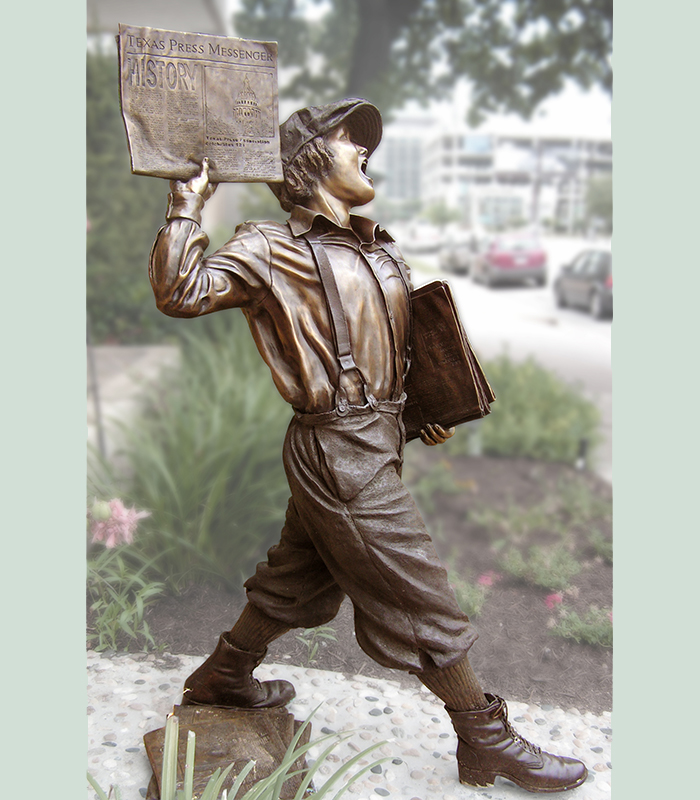
The Small Newsboy:
An edition of 100 the cost is $1,350. plus shipping.
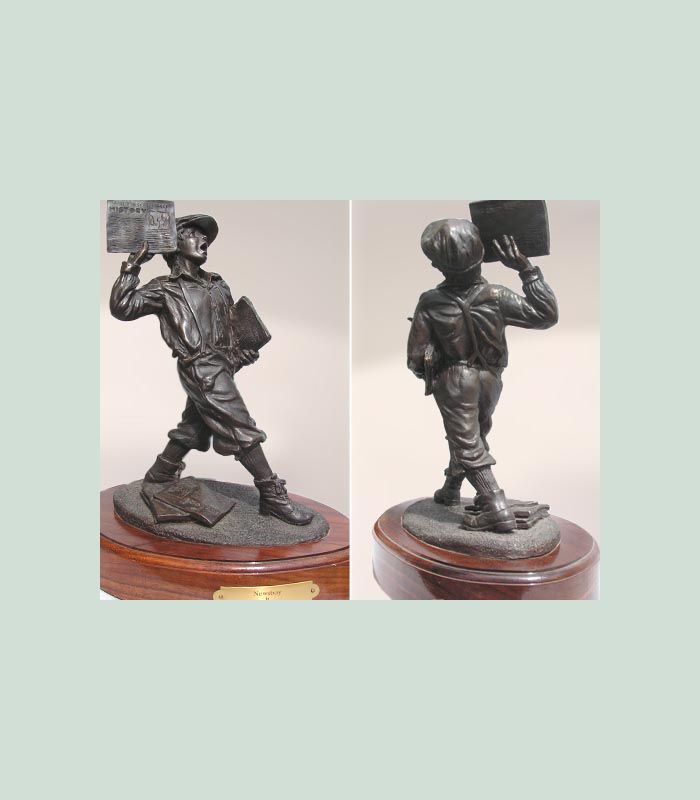
You can read about the entire process by following this link of posts.
Newsboy-Completion Of The Newsboy Sculpture
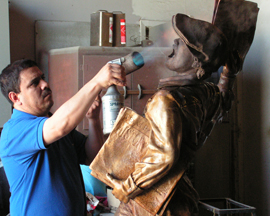
by using chemicals on the heated bronze.
May 2005
Sculptor Bridgette Mongeon has documented the entire process of creating a figurine of a newsboy and a life-size bronze sculpture. Watch the artist work through these posts. In this blog, she has also included information for students and teachers. In the previous post, we found out about putting a sculpture together in metal and what can happen.
If you are lost and want to go back to the chronological running list of posts, follow this link.
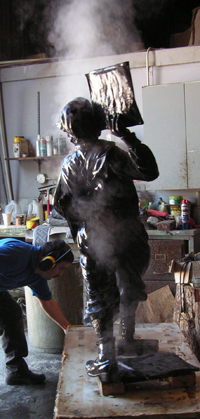
foundry on how to create
the color on the bronze
sculpture. She lets him
know what areas she wants light
and what areas she wants
dark. It is a bit of a process,
but, like the rest of this sculpture
process it is worth it in the end.
It has been almost eight months since the beginning of the newsboy sculpture. We are now in the final stage of the process- the patina. Putting different chemicals on the hot metal so that they will cause a reaction creates the patina. The part of patina is a true art. I wish I knew all of the different chemicals and what they can do. Often, I’ll just ask them, “A little more yellow here.” The patina that will be put on the newsboy sculpture is a traditional patina. Traditional patinas don’t have any stark colors, no blue, green or white. The patina on this sculpture may change over time. Chemicals in and pollution the air can make a patina turn different colors. Water from a nearby sprinkler can also have an affect on the sculpture. The sculpture is heated with a torch and chemicals are sprayed or brushed on the hot metal. It is interesting to see the steam rise off of the newsboy. Sometimes the sculpture will be rubbed back using steal wool or brushes. This brings the metal back while allowing the color to set into the crevices.
I typically like to have lights and darks; the hat will be dark, his shirt lighter, the suspenders darker, pants dark, socks lighter. The difference between the light and the dark helps to make the sculpture look more striking. The different textures I have added to the outfit seem to add color by the affect the patinas have on the textured areas. This adds color without really adding anything.
When I am asked for my opinion of the patina it is always hard for me to see what it will look like when it is waxed. To get a good idea they quickly spray the sculpture with water so that I can see what it will look like with the wax on top of it. I give my final approval and the sculpture is complete.
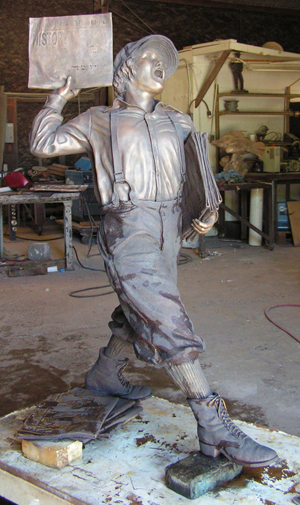
She wanted movement and passion.
She wanted to remember boys and
young men that were a part in history.
NOTE: Much to my dismay I have learned that the sculpture did not get through the legislature process at the state capitol. There were some stipulations that the capitol did not want sculptures by individual organizations. In other words, would be appropriate to have a war memorial, but because this sculpture is by the Texas Press Association, a group, that is not acceptable.
That is a shame, because in my personal opinion the newsboy represents more than the Texas Press Association. It represents how children had a profound affect on our history, and the importance of the news throughout history.
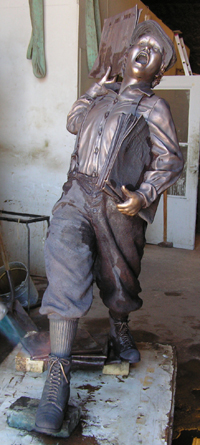
I have been told that if it cannot be placed at the capitol as of yet. Until the political details are resolved The Newsboy will be installed at the Texas Press Association building just south of the Capitol at 718 W. Fifth St. in Austin, Texas.
Sadly, this ends the newsboy journal. Two sections that were not covered in this documentary was Installation and Dedication. Those are featured in the process pages of John Turner of this website
The rest of the links on the main link chronological page are either news concerning the newsboy or about purchases of other pieces in the editions
DO YOU WANT A NEWSBOY SCULPTURE?
Newsboy-Correcting The Metal
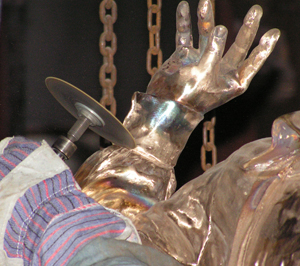
April 12th-May, 2005
Sculptor Bridgette Mongeon has documented the entire process of creating a figurine of a newsboy and a life-size bronze sculpture. Watch the artist work through these posts. In this blog, she has also included information for students and teachers. In the previous post, we watched the foundry put the metal together.
If you are lost and want to go back to the chronological running list of posts, follow this link.
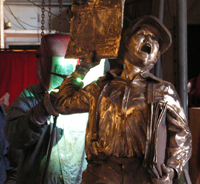
We have just seen how the metal was made, and how it was put together. Time to correct the metal. The newsboy is all together, or almost together. I am making several trips to the foundry to be sure that everything is the way it should be. Walking around the sculpture I circle different areas with a marker. The foundry then can be sure to look more carefully at these areas. We did have one major change. After looking at the sculpture with the newspaper in his right hand I did not feel that the hand was positioned in the way that I sculpted it. Maybe something changed in the wax or when attaching the many pieces. So, they cut off the arm at the cuff and turned it. Then welded it back on again. It amazes me what these guys can do.
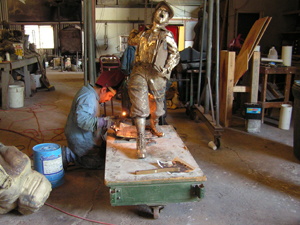
Once the arm was welded on we went to the newspapers at his feet. The newspapers were created so that they would balance tech heavy metal sculpture. They waited for me to position the papers and the carefully welded them to his back foot.Now that the sculpture is approved and together they will sandblast him one more time and we are on to the final process. The patina!
Don’t stop now, watch the next part of the process and the Completion of the life-size Newsboy sculpture.
Newsboy-Putting The Metal Together
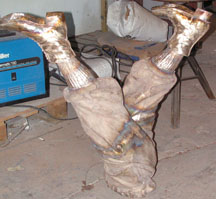
March 16-April 30, 2005
Sculptor Bridgette Mongeon has documented the entire process of creating a figurine of a newsboy and a life-size bronze sculpture. Watch the artist work through these posts. In this blog, she has also included information for students and teachers. In the previous post, we watched a bronze pour.
If you are lost and want to go back to the chronological running list of posts, follow this link.
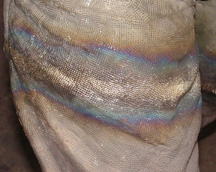
It is so much fun to pop in at the foundry and see the newsboy come together. The first day that I came to see how the metal was coming along I was greeted by these upside down legs. It made me giggle. Miguel, the foundry craftsman was working diligently on the metal. Each piece of the sculpture, once the ceramic shell is broken off of it, and it is sandblasted, is gone over very carefully by the craftsman.
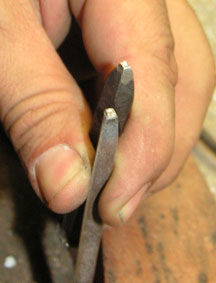
copy the artist’s texture.
I was quite concerned when they cut up the legs of the newsboy the way that they did, so they wax could be dipped and then it could go to metal. I knew they would have to weld these pieces together and I had put texture in the knickers. If they welded the legs together they would have to match my texture. Miguel, the foundry craftsman is absolutely incredible. He made his own tools and then painstakingly pounded the texture into the legs. Amazing!
Piece by piece the sculpture is being welded together. You can see that things are really coming along. With cutting and piecing at so many different steps in the process, it is a relief to see the newsboy back together and that everything is fitting. The newsboy has a handle on his head. This handle is to be able to keep the sculpture standing when they are fitting the pieces together. We are getting closer and closer to finishing.
Time to move on. There is more to do with putting the metal together and Whoops! There was an error that needs correction.
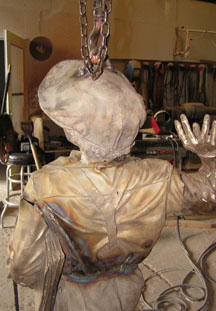
the newsboy’s head. This helps to hold him
up while the foundry works.

Newsboy-The Metal Pour
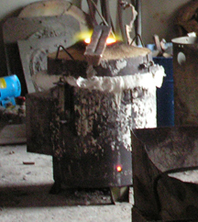
March 8-15, 2005
Sculptor Bridgette Mongeon has documented the entire process of creating a figurine of a newsboy and a life-size bronze sculpture. Watch the artist work through these posts. In this blog, she has also included information for students and teachers. In the previous post, we learned about the dip and making a ceramic shell.
If you are lost and want to go back to the chronological running list of posts, follow this link.
It was exciting to get a call from the foundry, “We are going to pour tomorrow, if you want pictures come on by.”
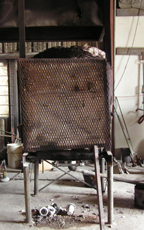
oven so that the wax can
burn out. In this cavity the
metal will be poured.
The foundry was a buzz with activity. The furnace roared in the corner announcing the event. The craftsmen had just poured one set of bronzes, which were glowing red on the pouring table. I shot some pictures of the glowing bronzes and then spoke with Scott, the foundry owner, about the rest of the process.
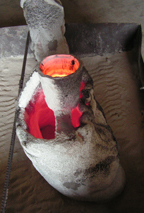
Wax is melted out and
it is ready to receive
the molten bronze.
The furnace is heated up to 1,950-2,150 degrees. Everdure bronze ingots consisting of copper 95.0%, manganese 1. %, silicon 4%, and other trace elements were resting on top of the lid of the furnace. I was told that it was important to heat them up and make sure there was not any moisture in the ingots. If there happened to be any moisture in an ingot when it was added to the molten bronze, a steam explosion could happen causing molten bronze to go everywhere. We had to wait a good 45 minutes for more bronze to melt before we could see the second pour.
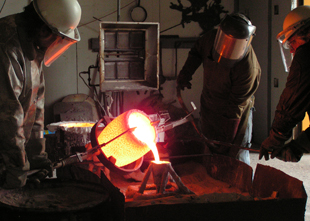
Meanwhile, remember our dipped pieces of wax that were covered in a shell? The wax is burned out of the shell in a furnace, thus the term “lost wax method” of bronze casting. Once the shells are heated up again (the 1,200 degree furnace is shown to the left) they are ready to receive the molten bronze.
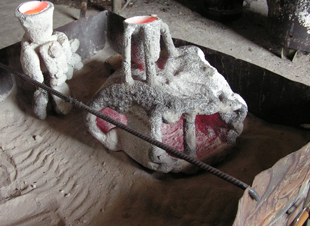
The heated shells are poured while they are balanced in a pouring table. This table, filled with sand, helps to contain any bronze that should come out of cracks, should our shell have some problems.The crucible holds about 140 pounds of molten metal. Scott tells me that it is not just the heat of the process that is tiring but also the lifting of the heavy crucible. For safety reasons they only pour 3-4 crucibles a day. It takes three people to pour. Someone guides the crucible – the lead pourer, while the second person helps with balance- the deadman. A third person is there for safety and skims the crucible of impurities before it is poured.Before we knew it the pour was done! Our shells had no problems and held all of the bronze quite nicely. After an hour or so the pieces are removed from the sand pit for devesting. With hammers and chisels the shells are carefully broken off of the newly cast bronze pieces. All of the gates and cups that poured with the bronze art will need to be removed and the pieces will be sandblasted.
Now that all of the pieces are poured the foundry brings our Newsboy to the next step- welding him together.
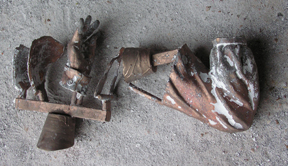
breaks off the ceramic shell.
STUDENTS AND TEACHERS
If you would like to know more about the bronze casting process watch this video from another one of Bridgette Mongeon’s projects. Want to know more about the making of metal over time? Check out this website that includes a wonderful infographic on the metals over time.
Newsboy- The Dip
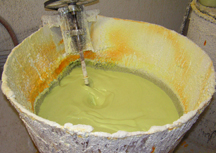
March 1-7, 2005
Sculptor Bridgette Mongeon has documented the entire process of creating a figurine of a newsboy and a life-size bronze sculpture. Watch the artist work through these posts. In this blog, she has also included information for students and teachers. In the previous post, we learned a little about cleaning the waxes that we got from the foundry.
If you are lost and want to go back to the chronological running list of posts, follow this link.
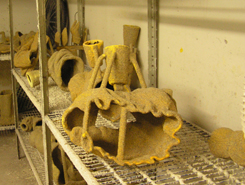
The sculptor went through great
pains to create an entire sculpture
and it is cut into pieces for bronze casting.
Now that the waxes that we worked on have been gated up by the foundry, and degreased, they are ready for the dip. There are two slurries, a thick and a thin one. The first dip is in the thick slurry. The color of the slurry is just something that is added to help the foundry craftsmen see the drying process of each dip. Once the piece is dipped in this liquid it is then sprayed with fine sand. These first two coats of dip and sand are to hold the detail of the piece. The dip room is kept at a certain temperature. If the temperature fluctuates in the dip room it could affect the shell that is being built, and then when they try to pour metal into this shell it could crack. You can only imagine what a problem that would be, molten bronze going everywhere.
Two coats are not enough; there must be several more coats of shell. The latter coats are for strength and have stucco in them. There are a total of 5-12 coats with 1-2 dips per day. It took a week to dip our entire sculpture.
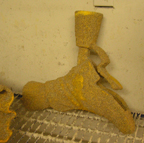
shows the pouring cup.
Each of the wax pieces
has gates that help
the gases escape and
the metal pour properly.
To the left you can see the upper torso and several pieces of the newsboy on the shelf. These photos give you a good look at the pour cups and the gating. Do you see the shoe? You can see how the bottom of the shoe has been cut as well. The photo to the left shows the upper torso. It appears they have cut off the newsboy’s head and arms as well. These photos show only the beginning of the dip. Once these dip pieces are ready. They will go to the furnace to be burned out and the metal will be poured.
Newsboy- Working the Waxes
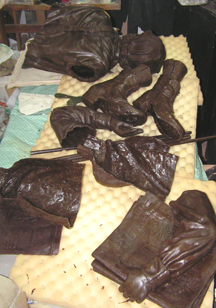
All of these will be made into metal.
February 22-28, 2005
Sculptor Bridgette Mongeon has documented the entire process of creating a figurine of a newsboy and a life-size bronze sculpture. Watch the artist work through these posts. In this blog, she has also included information for students and teachers. In the previous post, we learned a little about pouring the wax at the foundry.
If you are lost and want to go back to the chronological running list of posts, follow this link.
The steps to the bronze process never cease to amaze me. Here are some of the many waxes that came from the molds, of the newsboy sculpture. Over the years, whenever I pour in bronze, I have always worked my waxes. Not all artists do this. Many times the foundry will do the basic work. Now I have my assistant do that part, but I always like to add my own touches to each wax. You can imagine that even though this life size newsboy is an edition of 10 and the smaller newsboy sculptures are editions of 100, each number sculpture in the edition may be a little different. Because there are many pieces to put together for each finished bronze the finished sculpture will have its own nuances to it.
My assistant, Miguel, and myself spent hours making sure that each wax seam was cleaned up and that each piece not only fit to the other wax piece, i.e., front to back but also to each other, i.e,. leg to foot. Though we do a lot of fitting in the wax, some fitting will also be done in the metal.
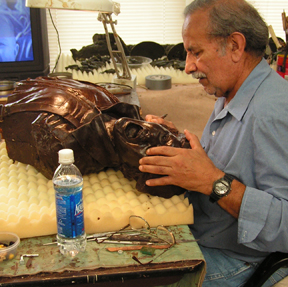
the studio. We need to clean up all of the waxes.
You can see by the many pieces placed upon the egg crate foam, the lower torso was cut up into several smaller pieces. This is done for several reasons. You will see later that the foundry will cut up the sculpture even more. It is important that these pieces should not be too cumbersome through the next steps of the process. Weight and ease of handling will be an issue when the pieces are being dipped or when the metal is being poured.
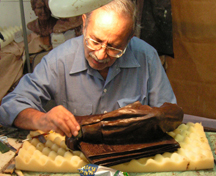
When I finish this part of the wax I will bring the many body parts back to the foundry for the foundry to gate up. Gating up is the process of adding wax vents and pour cups. The master foundry craftsmen want the molten metal to pour very smoothly so they add these vents to facilitate that process.
So, it is back to the foundry for gating up and making the shells.
Newsboy- Pouring The Wax In The Mold

mold and rolled around.
A thin layer of wax is
all that is needed
for the sculpture.
February 15-21, 2005
Sculptor Bridgette Mongeon has documented the entire process of creating a figurine of a newsboy and a life-size bronze sculpture. Watch the artist work through these posts. In this blog, she has also included information for students and teachers. In the previous post, we learned a little about the making of the mother mold in fiberglass.
If you are lost and want to go back to the chronological running list of posts, follow this link.
It is taking us some time to make all of the mold for the Newsboy. We took several of the mold pieces to the foundry to pour waxes. Once they are poured, we will be able to take these waxes back to the studio to work on them a bit more. Within the next few weeks the entire wax will be at the foundry, and at that point it will be ready to go into metal.
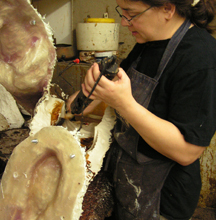
Here we are at the foundry pouring the wax into the upper torso. The wax is very hot. It is poured into the mold and carefully turned to cover the entire upper section. It must be just the right thickness. Any excess wax is poured out before it cools. Not only do we have to pour the wax upper torso, but we also have to pour the right arm, the paper that the newsboy holds in the right hand, the left arm and paper, the brim of the hat, and the papers that will sit on the ground. The lower part of the body will not be poured; instead it will be brushed on. Once the sections, front and back of the lower half, have cooled they will need to be put together.
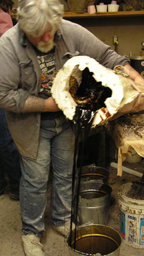
into the mold and swirls
it around and pours it out.
They will do this several
times to get the right
thickness of the wax.
The metal will be as thick
as the wax.
Now that the waxes are poured, it is time to clean up the studio. That way we can be ready to bring the waxes back to work on them. The platform was taken off the floor this week, and it felt so good to be able to have a little more space. I danced through the area. What is left of the newsboy sculpture is lying in a heap on the floor. The original sculpture is lost in the mold making process. I’ll soon disassemble him. The clay body parts will be going into a big bin to be melted down for the next projects, a six year old ballerina a two year old little boy holding his truck or Patsy a woman sitting on a park bench. Yes it is a little strange to see a hand melting in the crock-pot, but it is always good to be able to reuse material.
With everything cleaned up in the studio we are ready for the next step, to get the waxes from the foundry so we can make them perfect.
Newsboy- Rubber and Fiberglass
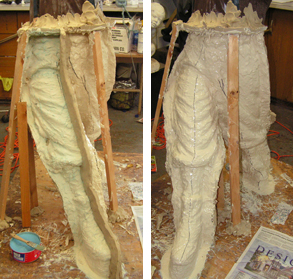
fiberglass mother mold is added
to the mold. It is created in parts.
February 8-14, 2005
Sculptor Bridgette Mongeon has documented the entire process of creating a figurine of a newsboy and a life-size bronze sculpture. Watch the artist work through these posts. In this blog, she has also included information for students and teachers. In the previous post, we learned the first part of the mold making process.
If you are lost and want to go back to the chronological running list of posts, follow this link.
Making molds is grueling work. We have just finished doing the rubber. Now on to the next stage of the mother mold. The days have been long and the nights even longer. Many nights I have worked until 1:00 a.m. I am glad the difficult part of this sculpture is almost over. I am exhausted, and I am finding that I need to rest my hands every few days.

fiberglass. This is called the
mother mold.
The mold is complete now; however, there are a few things for which I am working to make it perfect. Here is a little more about how the process went.
THE PROCESS CONTINUES
To the right you can see the rubber on the front of the mold. After the rubber, the fiberglass mother mold is applied.
Making a fiberglass mother mold is an itchy, smelly process. Remember I have decided to create a fiberglass mother mold because it will store easier and will be lighter. I had to complete the front part of the rubber and create the mother mold section in several pieces. The photo in the upper right shows my marks on the rubber where I am going to make the fiberglass seams.
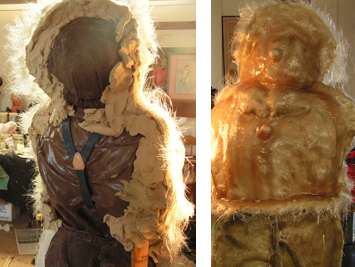
Soon that will harden and the seams will
be taken off so we can do rubber and clay on the back.
When creating the mother mold, sometimes it needs to be divided up into sections, as you can see with the front of the mold. These sections are so that the mother mold can be pulled from the rubber without hurting the wax that will be poured inside.
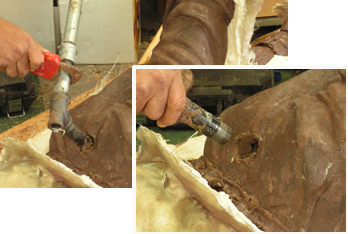
support out of the sculpture. Then the area will be
sculpted before the artist makes the rubber
mold with a fiberglass mother mold.
I worked on the entire front of the newsboy. Here you can see the fiberglass mother mold from the front and back before the edges are trimmed up.
Once the front of the sculpture was done, it was sturdy enough for me to lay the sculpture down. You might remember there was a pipe armature in the newsboy’s back. This was to hold up the entire sculpture while I sculpted. I could not make the mold around this pipe so we unscrewed the pipe from the base, laid him down and the unscrewed it from his back. Then I filled in the hole before we preceded with the lower half of rubber and mother mold.
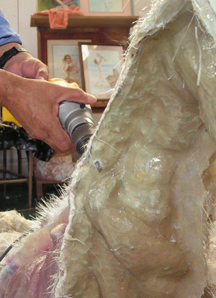
Once all of the rubber was brushed on the sculpture, and then each piece of the mother mold applied over the rubber then we had to drill holes in the seams. That connected the pieces. Later nuts and bolts will hold the sculpture together. These will not only secure the sculpture, holding it together, but will assist in quick demolding. Trying to pull apart the mold for the first time, after all the rubber and fiberglass are done, is a job that requires some muscles. My fancy white suit protects me from the pieces of fiberglass.When all of the pieces are off the original sculpture, the edges are ground down to form a smooth edge and each piece is sanded. The rubber needs to be cleaned before wax can be poured into it. Everything is reassembled for our trip to the foundry and to pour the waxes. The original sculpture is lost in the demolding process.
On to the foundry and pouring the waxes.

to work in fiberglass.
Newsboy- The Mold Making Process
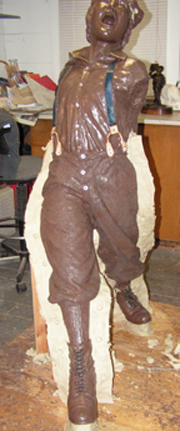
pieces and a mold is made.
Clay seams are put up each
side to divide the sculpture in half.
January-31-February 7, 2005
Sculptor Bridgette Mongeon has documented the entire process of creating a figurine of a newsboy and a life-size bronze sculpture. Watch the artist work through these posts. In this blog, she has also included information for students and teachers. In the previous post, we rejoiced that the sculpting is complete.
If you are lost and want to go back to the chronological running list of posts, follow this link.
Now that the sculpting is complete, let’s move onto the next portion of this process. The mold-making portion of the sculpture is underway. It is a lot of work and very physical. First, we cut off both of Dusty’s arms. This will enable us to pull the mold off of the sculpture. I also cut off the brim of his hat. I probably could have left it on, but I felt more comfortable cutting it off.
The process of making this mold is similar to the small newsboy sculpture mold. We are making a mold so that we can pour a hollow wax newsboy. To do this we sprayed the sculpture with a sealant, and then with a mold release agent. Layers of rubber are carefully painted on the sculpture. When they are dry, an outer mold called the mother mold is placed over the rubber. It is called a mother mold because it holds the rubber in place. If we just had rubber, then when we pour wax into the mold it would become distorted. The mother mold helps to keep the form.
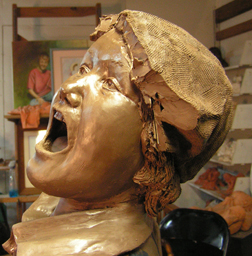
This will make it easier for the
artist to get a good mold of his face.
The head is prepared to go
into the mold making process.
I have documented another mold making process on my web site. The Kipper Mease mold is different than this one. Kipper’s mold was done with a plaster mother mold. This newsboy mold will be done with a fiberglass mother mold. Fiberglass mother molds are difficult to make, but they are lightweight and easy to store.
Once I have the mold, I will take it to the foundry and together we will pour waxes. I still don’t like to let go of the project yet. I will take the waxes back to the studio and work on them as well. When I am sure they are ready, they will go back to the foundry, and then my workload and long days will slow down for a bit. But just a little while. I still have some commissions that I have not been able to finish in the rush of completing the newsboy, and I have two more life size pieces that need to be started in the next few weeks.
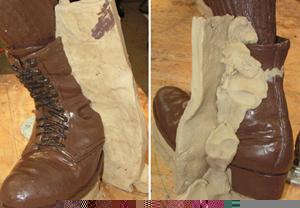
THE PROCESS
The sculpture is divided up into sections by what is called “claying up.” The the clay is carefully put on the sculpture. The front of the sculpture is what we are going to focus on first. You can see most of the seams of the lower half in the photo above. It does not; however, show the seam that will divide the torso in half.
Once the claying up process is done, I will coat this first section with coats of rubber. Each layer of rubber must cure to the correct consistency before another layer is put on. There is a total of 4-5 layers of rubber.
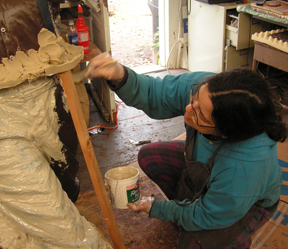
The rubber on the main sculpture is divided up into 4 pieces- front lower torso, front upper torso, back upper torso, and back lower torso. Each front section must be clayed up, and sprayed with mold release. Rubber must be painted on and then finally a section of mother mold applied to the top of that. Once one section is complete, then I can start on another section. It is a long process. While the rubber cures, I will work on other parts of the sculpture. The stick next to the sculpture, in the photo to the right is to help hold up the seam of clay.
Remember, I have several pieces that I have cut off the sculpture. Each of these needs to be clayed up and then rubber painted on each side. The left arm with the newspapers is shown in the photo to the left. Knowing how to clay up a piece takes a lot of thought and practice. You must be able to think ahead to the next steps that the piece will go through— the wax, dip and casting. Now, let’s move along in our process of making this sculpture into a bronze. On to making a mother mold with fiberglass.
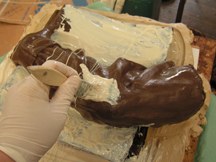
clay. And a mold is made of both
newspaper and arm
